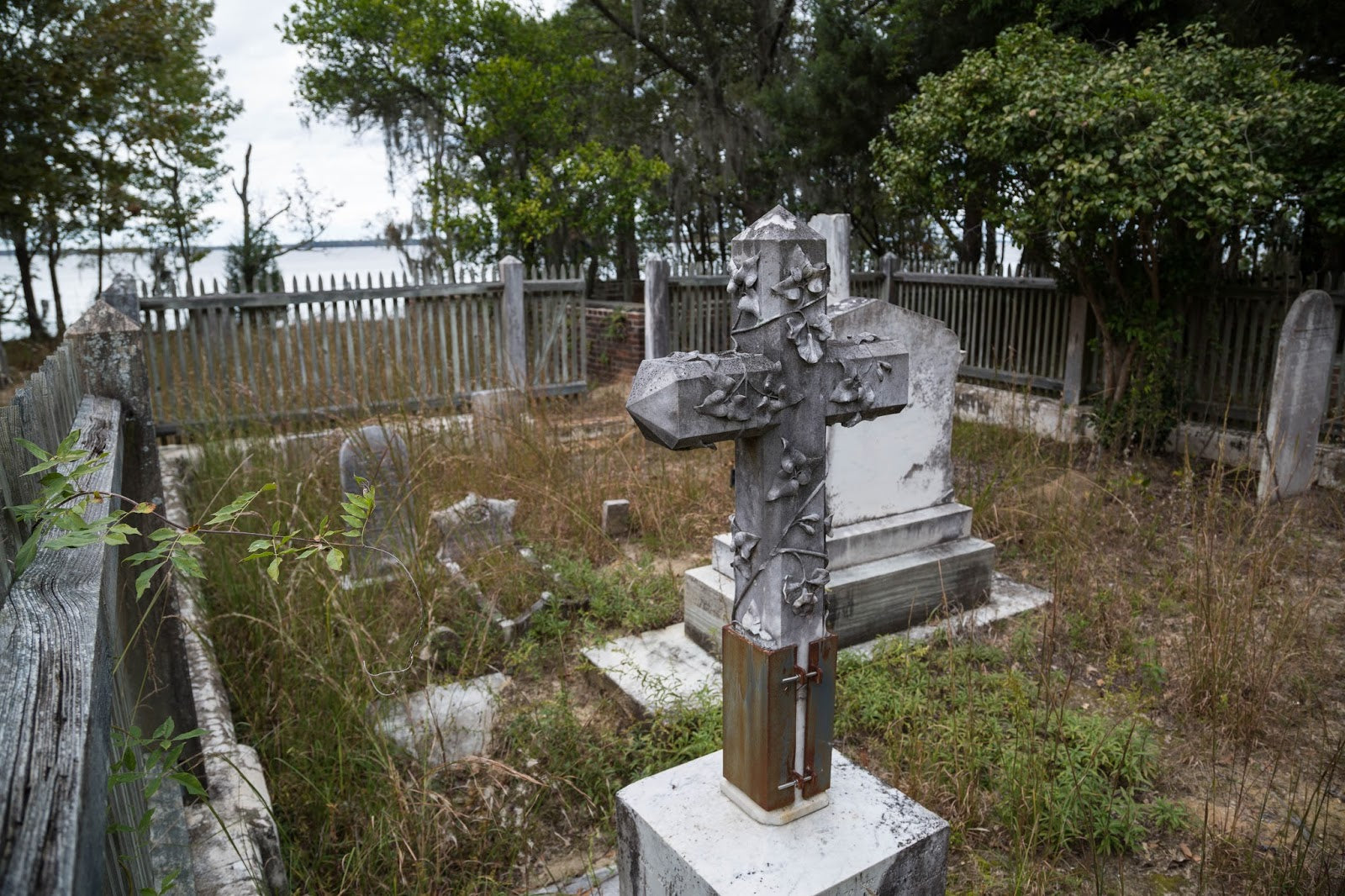History and Founding
Church Island is a flooded historical site in South Carolina with roots in the early 19th century. Originally, this patch of high ground on the Santee River was home to “Rocks Church,” an Episcopal chapel of ease established around 1804 near Rocks Plantation. For over a century it served local plantation families, and a small graveyard grew around the church. The island as we know it was created in the early 1940s, when the Santee-Cooper Project dammed the river to form Lake Marion for hydroelectric power. During the reservoir’s filling, many towns and farms were submerged, but the church’s cemetery happened to sit on land just high enough to avoid. The Episcopal congregation relocated inland to Eutawville (forming today’s Church of the Epiphany) as the waters rose, deconsecrating the old chapel sitecharlestondailyphoto.blogspot.com. The abandoned church building stood for a time on the new island until it was demolished in the 1950s, with only a brick memorial and tombstones left to mark its presence. Locals dubbed the place “Church Island” in honor of the lost church, and the graveyard – known as Rocks Cemetery – remains as a poignant relic of the community that once thrived therecharlestondailyphoto.blogspot.com. Notably, the final burial occurred in the mid-1930s when a plantation owner, distraught by the coming flood, tragically took his own life and was laid to rest in the island cemetery just before the lake’s creation.
Geography and Natural Environment
Gravestones in the old Rocks Church cemetery on Church Island, surrounded by moss-draped trees and undergrowth, with Lake Marion’s waters in the background. Church Island is a small wooded island within Lake Marion, South Carolina’s largest lake (over 110,000 acres). The island lies near the community of Eutaw Springs/Eutawville, roughly where Orangeburg and Berkeley counties meet in the Santee Cooper lake system. Its landscape is characterized by thick vegetation and a canopy of hardwoods and pines often draped in Spanish moss. Along the shore, bald cypress trees emerge from the shallow water, giving the area a swampy Lowcountry atmosphere. The island’s interior includes a clearing where the historic cemetery’s weathered headstones and brick ruins sit amid grassy plots and forest understory. Because Lake Marion was created without fully clearing all timber, the surrounding waters contain flooded trees and stumps, contributing to a rich habitat.

📸 Image Reference: Church Island Adventure (October 2017)
Source: Charleston Daily Photo Blog
URL: http://charlestondailyphoto.blogspot.com/2017/10/church-island-adventure.html
The environment around Church Island is teeming with wildlife. Wading birds and raptors are commonly seen – osprey and bald eagles soar overhead, while great blue herons, ibises, cormorants, and even the rare wood stork frequent the lakeshore wetlands. Alligators inhabit the lake as well (typical of the region), though they are more often lurking in coves and swampy shallows. Aquatic flora such as water lilies, primrose, and the floating heart plant thrive in the shallows around the island. In warmer months the air hums with insects, and the dense foliage can be humid and buggy, whereas cooler seasons offer clearer views through the bare cypress stands. Overall, Church Island’s natural setting is a snapshot of South Carolina’s Midlands ecosystem – a mix of open freshwater, marshy fringes, and upland forest – all enveloping a tiny island of surprising historical importance.
Cultural and Recreational Significance
Church Island holds both cultural and recreational significance in the region. Culturally, it is a historic sacred site – essentially an outdoor museum of the 19th-century community that was displaced. The cemetery dates back over 160 years, with gravestones bearing names of prominent Lowcountry families and veterans. In fact, several Confederate soldiers from the Civil War era are buried on the island, among other local citizens from the 1800s. The preservation of this graveyard above water is quite remarkable given that thousands of other graves were inundated by Lake Marion. A commemorative plaque now stands where the church once did, reminding visitors of the Episcopal chapel that served the area until 1941. The site is still respectfully maintained; the Church of the Epiphany’s vestry and local volunteers periodically tend the cemetery (one may find fresh flags on veterans’ graves or signs urging respect for the hallowed ground). This continuity underscores the island’s religious and historical importance – it remains consecrated ground and a tangible link to the vanished townships of the Santee River valley.
Recreationally, Church Island has become an intriguing destination for adventurers, history buffs, and nature lovers. It is part of local lore as a “ghost island” – often mentioned alongside the nearby submerged ghost town of Ferguson – and draws kayakers, boaters, and photographers interested in its story. Paddling groups sometimes include Church Island on their routes, landing to explore the mossy graveyard and ruins amid a tranquil, if slightly eerie, setting. The island is featured in the Berkeley County Blueways trail system, which highlights it as an easy-to-moderate kayak trip with opportunities to see both historic ruins and wildlife in one outing. For the environmentally minded visitor, the blend of cultural history and natural beauty here is compelling: one can stand among centuries-old tombstones while hearing woodpeckers in the trees and looking out over miles of open lake. This unique atmosphere makes Church Island a small but memorable piece of South Carolina’s heritage landscape.
Accessibility and Tourism
Visiting Church Island requires a bit of planning, as there are no roads or bridges to it – water access is the only waycharlestondailyphoto.blogspot.com. The island is open to the public (there is no gate or admission, since it’s essentially wilderness), but reaching it means crossing Lake Marion by boat. Here are some key points on accessibility and visiting:
-
Getting There by Boat or Kayak: Most visitors launch from nearby landings on Lake Marion. Spiers Landing in Cross, SC (a Berkeley County park) is a popular put-in for paddlers, located a few miles south of the island. From there it’s an easy 3–5 mile round-trip paddle among scenic islands to reach Church Island. Alternatively, Ferguson Landing near Eutaw Springs offers access from the north side; it’s closer to the remnants of Ferguson and about a 2-mile open-water paddle to Church Island. Boaters with motorboats can also navigate to the island – the GPS coordinates are not formally posted, but experienced Lake Marion boaters know the general area (near Marker 79 on some lake maps). It’s wise to use a GPS or map when venturing out, as the lake’s many coves and islands can be confusing.
-
Guided Tours: For those without a boat or unfamiliar with the lake, guided tours are available. Local outfitters, such as kayak tour companies, regularly include Church Island on their itineraries. These guided trips often depart from around Santee or nearby state parks and provide all equipment. A typical tour might be a half-day paddle that includes a landing on Church Island and a walking tour of the old cemetery. The guides share the island’s history and also point out wildlife during the journey. Some fishing guides on Lake Marion are also willing to make a stop at Church Island if arranged in advance, since the spot is of interest to history enthusiasts as well as anglers.
-
Visitor Experience and Amenities: It’s important to note that Church Island is undeveloped – there are no facilities or amenities on the island. Visitors should come prepared as if hiking or primitive camping (though camping overnight here would be unusual given the graveyard). There are no docks, so boats must be beached on the natural shoreline. Sturdy shoes are recommended; the ground is uneven, with vines, fallen branches, and occasional wildlife underfoot. The atmosphere is quiet and a bit secluded, so it’s best to go with a group or inform others of your trip for safety. Respect for the site is paramount: the gravestones and memorials should not be disturbed or defaced. The Episcopal Diocese asks that visitors treat the area as sacred ground – essentially, you are walking through a historic cemetery in the woods. Pack out everything you bring in, and leave no trace beyond footprints.
In terms of tourism infrastructure, Lake Marion’s surrounding area has several state parks, campgrounds, and marinas (for example, Santee State Park is on the far side of the lake). While none are on Church Island itself, they can serve as base camps for adventures. The island is a highlight for niche tours focusing on history or nature, but it remains a relatively off-the-beaten-path attraction. This means you won’t find crowds of tourists here – on a given day you might have the island entirely to yourself, or perhaps cross paths with a few other curious explorers. For those interested in South Carolina’s Lowcountry history, or simply looking for a unique kayaking destination, Church Island offers a rewarding excursion. Standing on this tiny island, one can truly appreciate how history and nature intertwine – with tombstones telling of a bygone community even as lake breezes and bird calls bring the scene to life around you.


